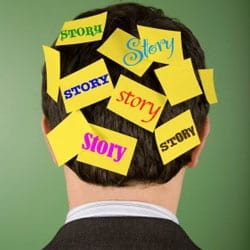Every day you wake up to a flow of information. Your alarm clock sounds and you check your smart phone for email and Facebook posts. You scan a newspaper over breakfast; listen to the radio as you head to work. You get a warning about local traffic from your navigation device and have it search for the nearest coffee bar on the detour. Your assistant sends a text message saying that your first meeting has been delayed. Your day has only just started, you haven’t even sat down at a computer and there is already a constant conversation. It’s the same for your customer.
We live in a socially-networked, transmedia world. The wealth of information across so many channels is both an opportunity and a challenge. We need effective organizing systems and filters that connect information in the world with things that have meaning and relevance. This is true of the sender and the receiver. We need to find a way to break through and hear or be heard, whether you are an individual, an organization, or a brand.
Transmedia storytelling is quickly becoming the new standard for 21st century communication because it is the solution to rising above the digital noise. Transmedia storytelling uses the tools of the storyteller-emotion, engagement, universal themes, personal connection, and relevance-to create a communication experience instead of a message. Get over thinking it is only about entertainment franchises. Transmedia storytelling moves a brand from slogan to interaction between the company and the customer. It unites executives and teams with focused goals and a common purpose.
Stories are the brain’s way of organizing information – in other words, how we rise above the noise. Stories package information for rapid comprehension by engaging the brain at all levels: intuitive, emotional, rational, and somatic.
The reason that we keep saying that traditional marketing approaches no longer work is that the social web has created a new consumer psychology. Consumers expect you to earn their attention, not interrupt them for it. They want to see communications that are timely, interactive, personal, and, above all, honest. Whether you’re an organization or an individual, you must communicate in a way that treats the audience with respect and delivers value–before the sale. A story can communicate who you are and inspire people at a higher level with your passion, purpose, and commitment to the customer’s experience. It is not about selling, it’s about engaging. It’s only by engaging people that you can move them from pre-customers to brand advocates.


 Dr. Pamela Rutledge is available to reporters for comments on the psychological and social impact of media and technology on individuals, society, organizations and brands.
Dr. Pamela Rutledge is available to reporters for comments on the psychological and social impact of media and technology on individuals, society, organizations and brands.
Great post as always Pamela. Strangely and coincidentally I wrote about story telling yesterday on my blog as well: http://www.grahamjones.co.uk/2011/blog/internet-psychology/story-telling-beats-facts-online.html
Interesting post, Pamela. I’m very aware of the power of story as a means of communication, but I guess I hadn’t given as much thought to story as the way our minds organize information. That makes a lot of sense. I teach a workshop helping people develop and tell their professional stories and my company has launched a new tool to help people present their stories in an engaging and interactive way online. Would love your feedback on what we are doing. http://www.intrvue.com.
Hi Jennifer,
Thanks for taking the time to comment. Your service looks like a great resource. It is very interesting and provides a great structure to help people build out an online resume with more life to it. You might be interested in the work my partner and I are doing at <a href="A Think Lab (http://www.athinklab.com“>A Think Lab (http://www.athinklab.com).
Kudos for taking us to the virtual edge and connecting the dots between dot.com and human mind maps! Hope you don’t mind my link to your page as reference for my readers….wordbone
[…] Transmedia Storytelling: Neuroscience Meets Ancient Practices(mprcenter.org) […]
Pamela, you say that consumers want to see communications that are, above all, honest. I agree that this is what they want to see. But is it want they are getting? The only thing I watch on TV is the news. And I have noticed that in the last few years even the news channels have become somewhat similar to the never ending reality shows. How purposeful or how much of a value to me or to you is the every day report (for 2 weeks) about Schwarzenegger’s adultery, or Rep. Weiner’s embarrassment? Media is becoming too gossip hungry. And while I believe that “a story” SHOULD “communicate who you are and inspire people at a higher level with your passion, purpose, and commitment to the customer’s experience”. It’s mainly become all about what’s going to sell and how fast.
PS. Before I changed careers and started working for a San Diego lemon law attorney, I worked as a counselor for a number of years.
Thanks for taking the time to comment! While the only thing you watch is TV news, it is influenced by what is happening on social media channels, too. But your point about sensationalism is well-taken. When cultivating a “story” for a brand, for example, I absolutely stand by what I said. With all the news about Weiner, Schwarzenegger, etc., does it reflect back on the news station? I think it does–if we even remember what network it is. That isn’t the kind of brand that will serve them in the long run, however many eyeballs it gets today. But the ultimate power is in our own control–using votes, dollars, and remotes!
[…] mprcenter.org – Today, 10:05 http://www.scoop.it/t/stories-an-experience-for-your-audience/p/995028514/transmedia-storytelling-neuroscience-meets-ancient-practices
[…] El transmedia es la utilización de herramientas del universo narrativo, emociones, temas universales, compromiso, conexiones personales y relevancia, para crear experiencias en vez de un mensaje, según rutledge 2011. […]